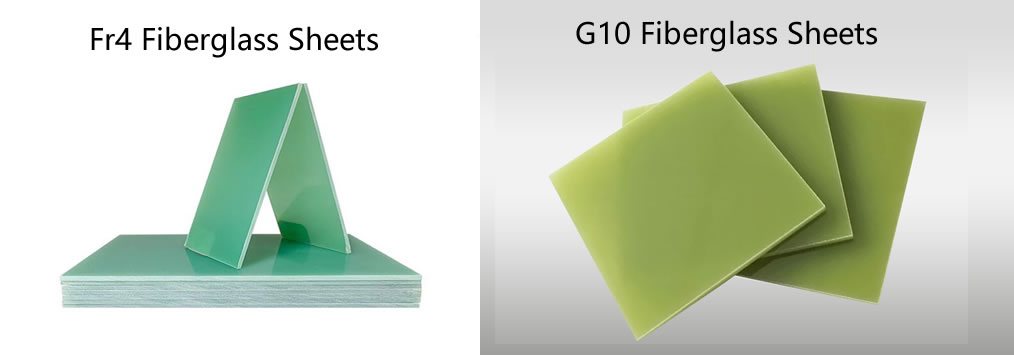What is the difference between G-10 and FR-4?
G-10 and FR-4 are both high-pressure fiberglass laminate materials commonly used in various industrial and electrical applications, but they differ primarily in their fire resistance and composition. Heres a breakdown of the differences: 1.
G-10 and FR-4 are both high-pressure fiberglass laminate materials commonly used in various industrial and electrical applications, but they differ primarily in their fire resistance and composition. Here’s a breakdown of the differences:

1. Material Composition:
G-10: This is a glass-reinforced epoxy laminate, made by stacking multiple layers of woven fiberglass cloth that is then impregnated with an epoxy resin. It's non-flammable but lacks specific fire-retardant properties.
FR-4: Similar to G-10 in terms of its base composition, but FR-4 stands for "Flame Retardant," meaning it contains a flame retardant additive in the resin. FR-4 is a modified version of G-10, designed to meet strict fire safety standards.
2. Flame Retardancy:
G-10: Does not include flame retardant additives and, while strong, may not meet specific fire safety standards.
FR-4: Specifically designed to be flame retardant and complies with UL94-V0 standard (meaning it self-extinguishes when exposed to fire).
3. Electrical Insulation Properties:
G-10: Excellent insulator but may not hold up as well as FR-4 in high-temperature conditions.
FR-4: Because of its flame-retardant properties, it is more commonly used in printed circuit boards (PCBs) and other electronic components that require superior thermal and electrical insulation.
4. Applications:
G-10: Used in applications where high mechanical strength and moisture resistance are required, like knife handles, structural supports, or certain insulating components.
FR-4: Primarily used in electronics, especially for PCBs, because of its flame resistance and stability under heat and electrical load.
5. Cost:
G-10: Generally slightly less expensive than FR-4 due to the absence of flame-retardant properties.
FR-4: Slightly more expensive due to the flame retardant additives, but preferred for electronic and safety-critical applications.
In summary, FR-4 is essentially a flame-retardant version of G-10. If fire safety or electrical applications are a concern, FR-4 is the better option; for general-purpose structural applications, G-10 may suffice.
Comparing G10 and FR4 Material Properties
When discerning the difference between G10 and FR4, it’s crucial to consider their material properties, which are pivotal in determining their suitability for specific applications.
Tensile strength: FR4 and G10 boast a tensile strength of 65,000 psi — excelling in resisting stretching forces.
Compressive strength: G10 takes the lead with a compressive strength of 40,000 psi, while FR4 follows closely at 38,000 psi.
Flexural strength: G10 exhibits a higher flexural strength of 75,000 psi compared to FR4’s 60,000 psi, making it more resistant to bending forces.
Bond strength: G10 holds an edge with a bond strength of 2,200 psi, whereas FR4 offers 2,300 psi.
Shear strength: G10 boasts a shear strength of 19,000 psi, while FR4 excels with 21,500 psi.
Hardness, M scale: G10 scores 110 on the M scale, whereas FR4 scores 115.
Specific gravity: Both materials share a specific gravity of approximately 1.8 to 1.85.
Flammability rating: FR4, as a flame-retardant material, carries a flammability rating of 94V-0, offering enhanced fire resistance compared to G10, which has a 94HB rating.
Maximum temperature: FR4 and G10 can endure temperatures up to 284 degrees Fahrenheit.
Water absorption: G10 demonstrates slightly higher water absorption at 0.11 than FR4’s 0.10.
Izod impact strength: Both materials showcase an impressive Izod impact strength, with G10 and FR4 registering 14.00 at 120 degrees Fahrenheit.
Understanding these distinctions is instrumental in making informed choices that elevate your products’ performance and reliability.
When to Use G10
G10’s exceptional qualities make it an ideal choice for various applications. Opt for G10 when you need the following advantages.
High mechanical strength: It withstands substantial stress, making it suitable for gears, bearings, or structural components.
Excellent dielectric properties: Ensures electrical insulation, preventing short circuits.
Thermal stability: Maintains dimension under temperature fluctuations.
Chemical resistance: Ideal for harsh chemical environments, ensuring longevity.
In niche scenarios, G10 shines where bromine content is a concern, particularly in cryogenic applications.
When to Use FR4
FR4, the industry-standard material, offers attributes vital for superior electronic performance and safety. Use FR4 when you need the following qualities.
Reliable insulation: For isolating electrical components and preventing shorts.
Flame resistance: It meets UL standard 94V-0 for fire safety.
Thermal stability: FR4 maintains integrity under temperature variations.
Cost-efficiency: It balances high performance with affordability.
In most scenarios, FR4 can effectively substitute for G10, meeting all G10 requirements due to its superior flame resistance. However, G10 takes the lead in cryogenic applications, as the presence of bromine molecules in FR4’s BPA epoxy resin can pose potential issues in below-freezing temperatures.
In exploring the difference between G10 and FR4, we’ve uncovered the unique properties and applications of these two remarkable materials. While G10 excels in high mechanical strength and dielectric properties, FR4 stands out with its flame resistance and electrical insulation capabilities. The choice between them depends on your specific project’s demands.
We encourage you to contact the experts at Ztelec Group.With our extensive inventory, rapid response, and advanced technology, we can help you choose the optimal material for your unique needs.
- Pre:What is FR4 laminated fiberglass sheet used for?
- Next:sorry!
